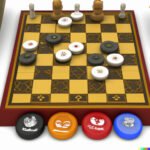Axis Allies Classic Board Game has been a staple in the world of strategic board gaming since its release in the 1980s. The game, which simulates World War II on a global scale, has captured the attention of players with its combination of historical accuracy and immersive gameplay mechanics. With its iconic map and detailed playing pieces, Axis Allies Classic Board Game continues to be a favorite among fans of strategy games.
The game is played by two to five players, each taking on the role of one or more of the major powers involved in the war: the Axis (Germany and Japan) and the Allies (United States, United Kingdom, and Soviet Union). Players must use diplomacy, economic management, and military strategy to outmaneuver their opponents and achieve victory. The game’s rules are comprehensive yet accessible, making it suitable for both casual gamers and serious enthusiasts.
Throughout the years, Axis Allies Classic Board Game has remained a beloved classic due to its dynamic gameplay that offers countless strategies and outcomes. The next sections will delve into specific tips and strategies for each faction, as well as provide an overview of the game’s components and historical significance. Whether you’re a seasoned veteran or new to the game, there’s always something new to discover in this timeless favorite.
Axis Powers
Playing as the Axis powers in Axis Allies Classic Board Game can be both challenging and rewarding. Here are some strategies and tips to help you maximize your strengths and overcome your weaknesses:
- Focus on early expansion: As the Axis powers, it’s crucial to take advantage of your early game strength in order to secure territory and resources. This will help you build a strong economy and provide a solid foundation for later stages of the game.
- Coordinate with your allies: Communication and coordination with your fellow Axis powers is key to success. By working together, you can strategically plan your movements and attacks, making it harder for the Allies to effectively counter your advances.
- Utilize air power: The Axis powers have strong air units, which can be used to gain control of strategic territories and disrupt Allied supply lines. Using your air power effectively can give you a significant advantage on the battlefield.
Maximizing the strengths of the Axis powers means understanding when and where to make calculated risks, as well as being proactive in expanding territory and coordinating with allies.
Remember that playing as the Axis powers requires an aggressive mindset while also being mindful of potential drawbacks such as stretched supply lines and vulnerable flanks. By implementing these strategies and tips, players can ensure a more formidable performance on their way to victory.
Allies Powers
Playing as the Allies powers in Axis Allies Classic Board Game can be a challenging but rewarding experience. Here are some strategies and tips for coordinating with your teammates and leveraging their unique strengths to achieve victory:
- Communication is key: One of the most important aspects of playing as the Allies is effective communication with your teammates. Coordinate your strategies, share information about enemy movements, and work together to make the most efficient use of your combined forces.
- Capitalize on individual strengths: Each Allied power has its own unique strengths and abilities. For example, the United States has a strong industrial base, while the United Kingdom has a sizable navy. Make sure to capitalize on these strengths and use them to your advantage in the game.
- Create a unified front: While each Allied power operates independently, it’s crucial to work together as a unified front against the Axis powers. This means coordinating movements and attacks, sharing resources, and supporting each other’s efforts on all fronts.
By following these strategies and tips, players can maximize their potential as the Allies in Axis Allies Classic Board Game and increase their chances of achieving victory against the Axis powers.
Map and Game Components
The Axis Allies Classic Board Game features a large, detailed game board that represents the various theaters of World War II. The map is divided into different territories, each with its own distinct characteristics and strategic importance. The game also includes a wide array of playing pieces, representing infantry, tanks, aircraft, battleships, and more. Understanding the map and game components is crucial for success in Axis Allies.
Game Board
The game board in Axis Allies Classic Board Game is an essential component that sets the stage for the entire gaming experience. It is divided into regions such as Europe, Asia, and Africa, each with its own set of territories and sea zones. Controlling these territories is vital for gaining income and positioning forces strategically.
Playing Pieces
Another key aspect of Axis Allies Classic Board Game is the diverse range of playing pieces at your disposal. These include infantry units to hold territory, armored units to provide mobility and firepower, naval vessels to control sea zones, and air units for strategic bombing or air superiority.
Impact on Gameplay
Understanding the map and game components not only adds to the visual appeal of Axis Allies Classic Board Game but also has a significant impact on gameplay. Knowing where to position your forces based on the geography of the board can make a difference between victory and defeat. Utilizing different playing pieces effectively can also give you an edge over your opponents.
As you delve into the world of Axis Allies Classic Board Game, familiarizing yourself with the map and game components will be fundamental for developing winning strategies and achieving triumph on the battlefield.
Notable Battles in Axis Allies History
Historical Representation
Axis Allies Classic Board Game is known for its historical accuracy in representing some of the most famous battles and events of World War II. Players have the opportunity to reenact pivotal moments such as the Battle of Stalingrad, D-Day, and the attack on Pearl Harbor. The game offers an immersive experience by allowing players to strategize and make decisions based on the real-life circumstances faced by military leaders during this time period.
Significance of Battles
Each battle represented in Axis Allies Classic Board Game holds significant historical importance. For example, the Battle of Midway was a turning point in the Pacific theater that led to a weakened Japanese navy. By recreating these battles, players gain insight into the challenges and strategic decisions faced by both sides during World War II. This not only adds depth to gameplay but also serves as an educational element, providing a deeper understanding of the events that shaped history.
Inclusion in Gameplay
The battles featured in Axis Allies Classic Board Game are integrated into the gameplay through various scenarios and objectives. Players must consider historical context, geographical positioning, and available resources when planning their strategies. As a result, each battle has a direct impact on the outcome of the game, making it essential for players to study and understand the significance of these historical events.
Axis Allies Classic Board Game vs Other Editions
When it comes to comparing the classic edition of Axis Allies to other versions, there are several key differences to consider. The classic edition, first released in 1984, is known for its balance and strategic depth, with a focus on historical accuracy. In contrast, newer editions such as Axis Allies: 1942 Second Edition or Axis Allies: Anniversary Edition may feature updated rules, units, and gameplay mechanics that offer a different gaming experience.
One major difference between the classic edition and newer versions is the game setup and starting unit compositions. While the core mechanics remain consistent across editions, the distribution and abilities of units can vary significantly. For example, the Anniversary Edition features additional unit types and revised starting positions for players, offering a fresh take on familiar gameplay.
The decision to play the classic edition versus other versions ultimately depends on player preferences and desired game complexity. Some may prefer the nostalgic charm and well-established strategies of the original game, while others may enjoy exploring new unit combinations and rule variations in modern editions.
| Classic Edition | Newer Editions |
|---|---|
| First released in 1984 | Updated rules and units |
| Focus on historical accuracy | Variations in gameplay mechanics |
Common Mistakes to Avoid
Playing Axis & Allies Classic Board Game can be a challenging and strategic experience, but there are several common mistakes that players should avoid in order to improve their gameplay. One of the most frequent errors made by beginners is neglecting the importance of logistics.
It is crucial to carefully plan and manage your unit movements, as well as supply lines, in order to maintain control over territories and maximize your chances of victory. Many players overlook this aspect of the game, leading to disastrous consequences for their forces.
Another common mistake is underestimating the significance of air and naval power. Players often focus too heavily on ground forces, while failing to recognize the potential impact that air and naval units can have on the outcome of battles. Understanding how to effectively utilize these units and integrate them into your overall strategy is essential for success in Axis & Allies Classic.
Additionally, a frequent error made by novice players is the inability to adapt their strategy based on changing circumstances. Flexibility is key in this game, as unexpected developments can quickly shift the balance of power on the board. Failing to adjust your approach and stubbornly sticking to a predetermined plan can ultimately lead to defeat. By learning from these common mistakes and making strategic adjustments, players can significantly enhance their performance in Axis & Allies Classic Board Game.
| Mistake | Impact |
|---|---|
| Neglecting logistics | Potentially disastrous consequences for forces |
| Underestimating air and naval power | Missed opportunities for affecting battles |
| Failing to adapt strategy | Risk of defeat due to inflexibility |
The Future of Axis Allies Classic Board Game
In conclusion, the classic edition of Axis Allies continues to hold a special place in the world of board gaming. Its blend of strategy, tactical gameplay, and historical significance has contributed to its enduring popularity among players. With its loyal fan base and potential for future updates or expansions, it’s clear that this game will continue to be a staple in the world of modern board gaming.
As the gaming industry continues to evolve with new technology and innovations, Axis Allies Classic Board Game remains a timeless classic that appeals to both history enthusiasts and strategy game fans alike. Its unique blend of gameplay mechanics, historical context, and deep strategic elements ensure that it will remain relevant for years to come.
With its rich historical backdrop and engaging gameplay, Axis Allies Classic Board Game is likely to remain a favorite among both casual gamers and serious strategy enthusiasts. Whether played for leisure or competitively, the classic edition holds a special place in the hearts of many players and will continue to shape the world of modern board gaming for generations to come.
Frequently Asked Questions
What Is the Original Axis and Allies Board Game?
The original Axis and Allies board game was first released in 1981 by Milton Bradley. Set during World War II, the game allows players to take on the role of one of the major powers (United States, United Kingdom, Soviet Union, Germany, or Japan) and strategize their way to victory through combat, production, and diplomacy.
Is Axis and Allies Board Game Good?
The Axis and Allies board game has a strong following and is generally considered to be a good game by fans of strategy games. Its classic gameplay, historical theme, and emphasis on both military and economic tactics make it an engaging experience for players who enjoy complex strategic decision-making.
Which Version of Axis and Allies Is the Best?
Determining the “best” version of Axis and Allies is subjective and depends on individual preferences. The classic 1984 version is beloved by many for its simplicity and balance, while later versions like Axis and Allies: Pacific or Axis and Allies: Europe introduce more specialized scenarios and rules.
Some players may prefer these spin-off editions for their added complexity and thematic focus. Ultimately, the best version is the one that aligns with a player’s interests in terms of historical period, complexity level, and length of gameplay.

I love playing all kinds of games – from classics like Monopoly to modern favourites like Ticket to Ride.
I created this blog as a way to share my love of board games with others, and provide information on the latest releases and news in the industry.





